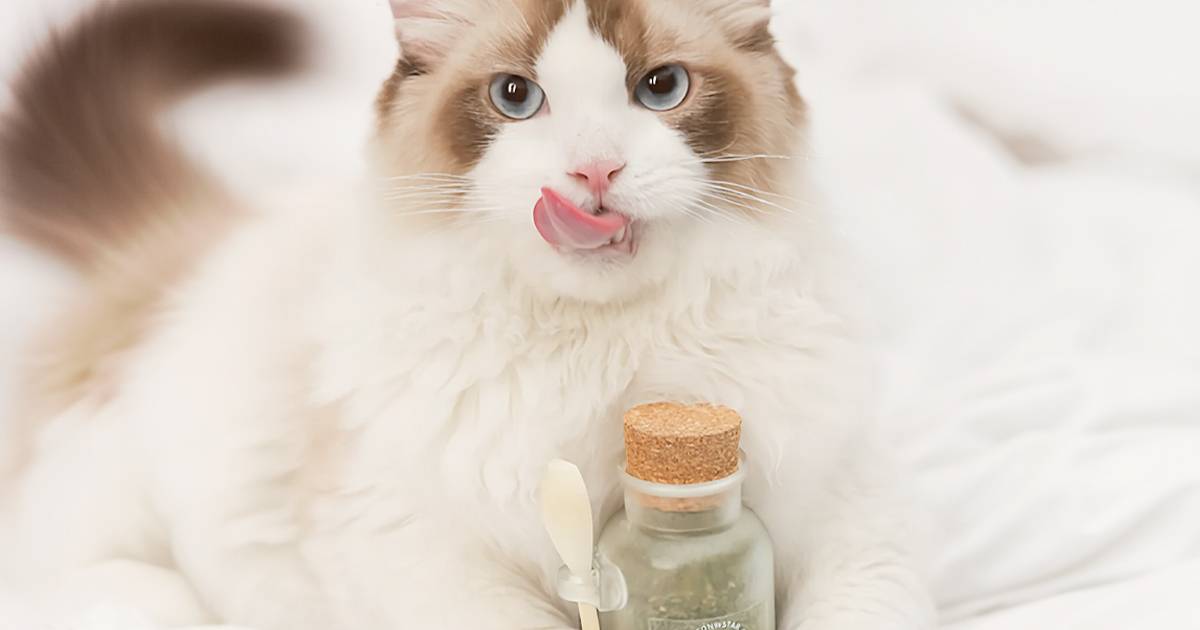5 Catnip Tea Benefits for Cats: Is it Safe?

Many pet owners are aware of cats’ affinity for catnip, but what about catnip tea? While catnip tea for cats can be safe, pet parents should exercise caution when dosing the catnip, especially as compared to treats that don’t require dilution. The safety of catnip tea hinges on proper dilution with water in a recipe. If you’re considering making catnip tea for your cat, ensure you do so safely by consulting your vet before introducing any form of catnip to your feline friend. Below, discover more about catnip tea benefits and find out if catnip tea is safe for cats.
What is catnip?
Catnip, a member of the mint family, is a versatile herb that thrives in various conditions, growing up to 3 feet high. The key player in catnip’s effect on feline behavior is a chemical called nepetalactone, produced in the plant’s leaves and acting as a stimulant. When exposed to catnip, your cat may become more active for 15 to 30 minutes, exhibiting behaviors like increased scratching, running around, flipping over, rolling, or staying calm. It’s worth noting that while a majority of cats respond to catnip, their reactions can vary.
How does a cat respond to catnip tea?
When cats catch a whiff of catmint without actually eating it, the presence of nepetalactone sparks joyous endorphins in their brains. This often leads to delightful behaviors such as rolling onto their backs, flipping, face rubbing, chewing, sniffing, drooling, stretching, licking, and even playful jumping. However, in certain instances, cats may exhibit signs of aggression or heightened activity levels.
On the other hand, when cats consume catnip, they typically experience a calming effect. These euphoric states induced by catnip, whether through scent or ingestion, usually last for a duration of five to ten minutes.
Why are cats obsessed with catnip?
Catnip contains an essential oil called nepetalactone, acting as a stimulant and relaxant for cats, similar to how humans respond to cannabis. This compound isn’t exclusive to domestic cats; big cats like leopards, tigers, and lions also appreciate it. If your cat doesn’t show much interest in catnip, it’s perfectly normal, as their preference is influenced by genetics and age. About one-third of cats lack the “catnip gene,” and kittens under 6 months old and elderly cats often don’t react to nepetalactone. This variability is akin to how genes affect human perceptions of cilantro.
Benefits of Catnip Tea for Cats
Since cats can drink catnip tea, discover more of its advantages below:
- When cats eat catnip, it makes them feel calm, helping with stress, anxiety, and feeling sad.
- Catnip can also help with tummy pain and bloating in cats.
- If your cat doesn’t like baths, using catnip can make it easier, especially if their skin is irritated. Just mix a tablespoon of dried catnip in hot water and add it to a warm bath—it might make your cat more interested in water!
- Cats can be fussy about their toys and get bored easily. If they don’t have fun things to play with, they might damage furniture or curtains. Catnip is a good way to distract them.
- Sprinkle some dried catnip on their toys and scratching posts to keep them busy and away from your living room stuff!
What to Do Before Giving Your Cat Catnip Tea
If you wish to give your cat the benefits of catnip, you can try making catnip tea for them. But, is it safe for cats? While catnip tea has its advantages, it’s crucial to think about your cat’s health and what they need before giving them catnip.
Talk to your vet first
Before giving your cat catnip tea, consult with your vet, as catnip is a stimulant that induces a high in cats. While it has various benefits, ensuring your cat’s overall health is crucial before introducing catnip. Regular veterinary checkups, ideally once a year, provide an opportunity to discuss catnip with your vet. Additional tests may be recommended, and your vet can offer specific, safe catnip suggestions tailored to your cat’s breed.
Follow your vet’s advice and the manufacturer’s instructions
When giving your cat catnip tea, carefully follow the instructions from your vet and the product’s manufacturer. Check the catnip amount closely to know how much catnip tea to give a cat, as different types may have varied dosages of active ingredients. Pay attention to the water quantity you add; more water dilutes the catnip effects, but too little can make the tea too strong. Start with a low catnip dose if unsure, following your vet’s guidance. If you consider increasing the catnip amount, do so gradually to avoid potential health issues for your cat.
Monitor how your pet responds to it
After giving your cat catnip tea, closely observe their reaction, as catnip is generally safe but carries some health risks. Mild gastrointestinal issues like constipation or diarrhea may occur. While catnip itself won’t cause physical injuries, it makes cats more active, potentially leading to accidents due to altered coordination. Administer catnip with proper supervision to ensure your cat’s safety and well-being.
Put your cat’s wellbeing first
Enhance your cat’s well-being with the benefits of catnip tea! While cats can have catnip tea, consult your vet for tailored advice. Follow precise instructions on dosage and water dilution, ensuring a safe experience. Observe your cat’s response closely, as catnip can bring joy but may have mild side effects. Elevate playtime by sprinkling catnip on toys, preventing furniture damage. Make catnip tea a delightful addition to your cat’s routine, fostering relaxation and playfulness.
